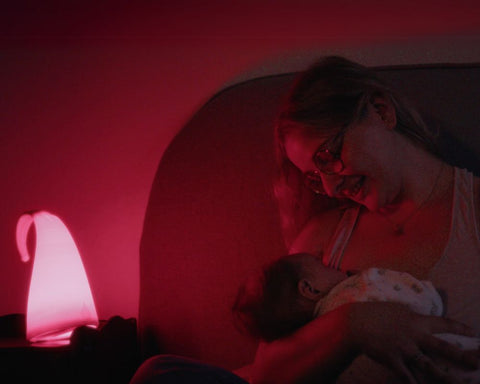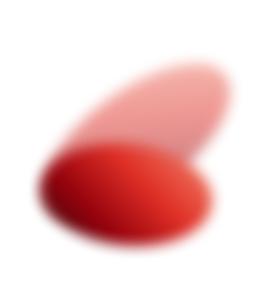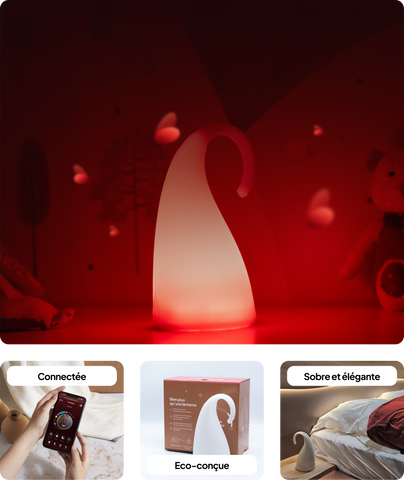Waking up in the middle of the night to breastfeed your baby is already quite a challenge — your sleep is broken, and fatigue builds up over time... But did you know that the lighting you use could significantly impact your ability to fall back asleep?
A light that's too harsh or poorly suited to nighttime use sends a 'wake up' signal to your brain, making it much harder to drift off again. Luckily, there’s a simple solution to help protect your sleep: red light.Breastfeeding at Night? Discover How Red Light Protects Your Sleep.
Red Light: A Sleep-Friendly Companion
We often hear that blue light should be avoided at night — but why exactly?
The type of lighting you’re exposed to before bedtime, or during nighttime awakenings, has a direct impact on your melatonin levels — the so-called "night hormone".
Blue light is everywhere in our daily lives: from screens to artificial lighting. During the day, it's absolutely fine — in fact, exposure to blue light (like natural daylight) is beneficial.
But come night-time, it's a completely different story.
Switching on a white or blue light in the middle of the night — whether to visit the loo, tend to your little one, or grab a glass of water — is like shouting to your brain: "Time to get up!"
The result? You can end up lying awake for what feels like forever. That’s because this type of light blocks melatonin production and disrupts your natural circadian rhythm. (link to article about circadian rhythm)
But here’s the good news: researchers have found that at a specific wavelength, red light doesn’t interfere with melatonin production.
In other words, if you use a red light (designed especially for sleep), your brain hardly registers that you’ve woken up. You’ll be able to slip back into sleep much faster — no more hours spent tossing and turning after that 2 am nappy change!
That’s exactly why we recommend red light for nighttime breastfeeding.
Red Light: Gentle on the Eyes and Helps Baby Sleep Through the Night
Some mums prefer breastfeeding in total darkness — but let’s be honest, it’s not always practical!
It can be tricky to position your baby correctly, check their latch, or even find a muslin cloth without knocking things over.
On the other hand, switching on a bright overhead light risks fully waking baby — and probably Dad too if he’s doing a bottle feed — unsettling everyone’s sleep.
The result? Everyone lies awake longer, and the fatigue just keeps building.
The solution? Red light! It’s the perfect balance: enough visibility without disrupting your natural sleep rhythm.
If you’re using the Byeblues lantern, you can even adjust the brightness to suit your needs, providing a soft and efficient glow.
Unlike standard lights, red light is gentle on your eyes, letting you look after your baby calmly and helping you fall back to sleep much quicker after a feed.
Naturally, it’s not just the parents who benefit — baby does too! Red light helps their little brain start learning to "sleep through the night", that much sought-after milestone.
On top of being sleep-friendly, red light is easy on the eyes and creates a wonderfully calming atmosphere in the nursery.
It encourages a smoother transition from breast to cot — for both baby and parents — by avoiding overstimulation and supporting healthy biological rhythms.
Conclusion
Nighttime breastfeeding is a deeply precious and intimate experience, but it can easily turn into a source of exhaustion.
That’s why it's so important to stack the odds in your favour — starting with sleep-friendly lighting.
With the right light, you’ll find it easier to settle back to sleep and transform those night feeds into gentler, more restful moments.
FAQ: Red Light and Nighttime Breastfeeding
Q: Why is red light recommended for nighttime breastfeeding?
A: Red light doesn’t suppress melatonin production, helping both mum and baby fall back asleep more easily.
Q: Will red light disturb my baby’s sleep?
A: Not at all — it creates a soothing environment that respects your baby's natural sleep rhythms.
Q: Can I leave a red light nightlight on all night?
A: Absolutely, as long as it's designed for nighttime use and the brightness is appropriately low, it won’t disrupt anyone’s sleep.




